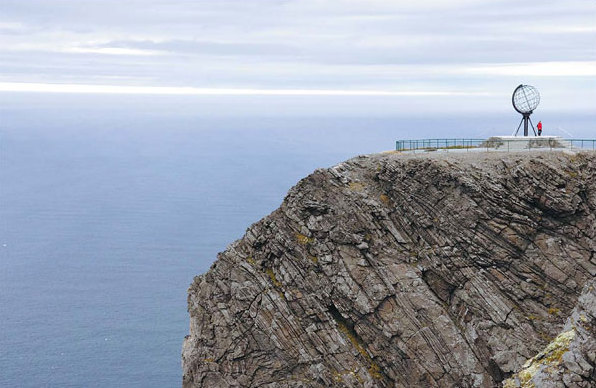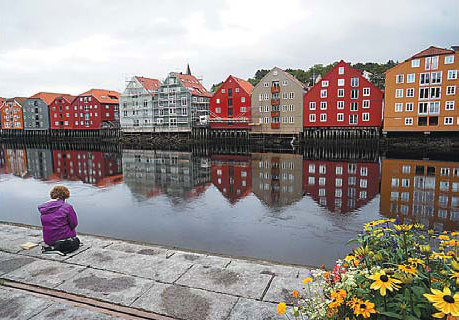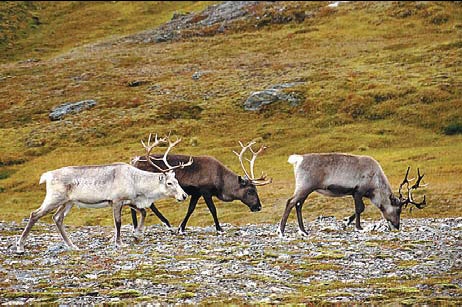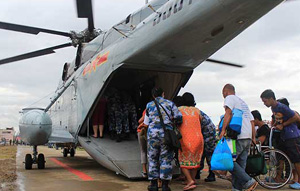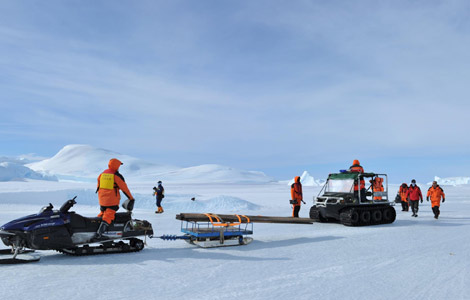Enigmatic ice world's unexpected warm embrace
Updated: 2013-12-08 07:07
By Sindy Chan (China Daily)
|
|||||||||||
A voyage to the Arctic takes passengers onboard a Hurtigruten ship on a 2,400-km voyage along the Norwegian coast on a sea passage started 120 years ago, writes Sindy Chan.
We are at London Gatwick Airport again. Flying is not my favorite option but I've found a solution this time. Staying at the Yotel, a small hotel of 46 rooms resembling first-class airline cabins inside Gatwick Airport South Terminal, is a relief for pre-departure anxiety. From London, we fly to Bergen for a Norwegian cruise to the Arctic. The last sight of Bryggen in Bergen is immediately recognizable as a row of wooden houses in maroon, beige, yellow and white colors standing tenaciously alongside Bergen Harbor. Surviving the vicissitudes of burning down and rebuilding, the old quayside architecture cluster is now a UNESCO Heritage-listed site - a time machine taking us back over a period of 500 years.
Bergen today is a plank to cruise passengers sailing the Norwegian coast - as we sail with the Hurtigruten.
|
The excursion to the North Cape is very popular for the opportunity to set foot on the northernmost point of the European continent. Pictured is the North Cape globe icon. Photos by Sindy Chan / For China Daily |
The Hurtigruten's ship MS Nordnorge (Northern Norway), takes us on a voyage of 2,400 kilometers along the Norwegian coast, through perilous reefs, small islands and narrow inlets, from Bergen to Kirkenes in the Arctic - a sea passage started 120 years ago.
"Hurtigruten ships have always been working ships," tour leader Harald Weinreich reiterates in the first passenger meeting aboard.
"A taste of Norway" is our first ashore excursion and it begins at Urke, where life is like a poem, as described in the village leaflet: "We are approximately 53 people in Urke, 10 children, 31 adults and 12 older Urke-people. In addition we have 20-plus cabin owners There are 14 people who work here The market garden gives us fresh tomatoes and vegetables. The fjord provides fish. In the Urke Valley, goats and sheep graze freely. The local power plant gives us electricity. If we need more, we take a trip to Orsta or Alesund. But most of all, we like to be self-sufficient in Urke Enjoy the view and good life in Urke."
Nestled in Norway's narrowest valley, Norangsdalen, in the translucent beryl-color water of Lyngstol Lake, we are led to discover some stone structures remain from ancient settlements of the region.
In the cradle of the towering Sunnmorsalpene Mountains, we pay a visit to historic Hotel Union Oye from 1891 and get to taste hearty local lamb broth in the hotel's authentic rooms.
The Svartisen, Norway's second largest glacier, is another world to me as a visitor from the subtropics. With a cup of hot coffee, I lose myself in the glacier's purity, the ice-blue landscape and its reflection on the lake. Our guide explains to us in the simplest terms how nature's chisel shaped this enigmatic ice world through millions of years.
"Years ago, the lake was part of the glacier," our guide says. "Glacier recession is one of the ways the earth is talking to us."
On our return along the coast of Helgeland to the ship at Bodo, we see Europe's largest predatory bird, a sea eagle, surfing the sky. I recall I read at Torquay's Living Coasts Zoo and Aquarium: "The great auk, gone forever like the dodo Extinction is forever. Endangered means we still have time."
In the early morning of Day 4, we cross the Arctic Circle. I join the cheering crowd on the open deck the moment we see the globe icon.
My husband Troy is overwhelmed when tour leader Weinreich announces there is a great chance to see the northern lights that evening.
Our new travel companion - the Hasselblad Lunar camera that had given Troy so much fun capturing very fine-quality high-definition pictures of the Svartisen glacier, or partial-red images of a lone lighthouse in the Norwegian waterway - is put to good use.
Aurora borealis is the academic name for the northern lights. Named after the Roman goddess of the dawn, Aurora, and the Greek name for the north wind, borealis, it is a natural light display in the sky particularly in the high-latitude (Arctic and Antarctic) regions, caused by the collision of energetic charged particles with atoms in the high-altitude atmosphere.
That night, on the open deck, I lift my head to a very dark sky. It starts with a regiment of light, and then, from the viewer of the Hasselblad Lunar camera, I see a fluorescent greenish glow expand to illuminate the northern horizon.
The northern lights were a random feature rather than the typical curtain-like structure. I had read how different amounts of oxygen and nitrogen emissions give out different colors, such as green, red or blue, and how the state can change within seconds or glow unchanging for hours. Because of that, it has a beautiful nickname: Dance of the Spirits. But I am content with what I saw - and deem it to be a lasting impression.
The excursion to the North Cape is very popular for the opportunity to set foot on the northernmost point on the European continent and meet the indigenous Sami people of Scandinavia.
Our guide describes an idyllic picture. In spring, Sami people bring their herds of reindeer by boat to the North Cape Plateau. The Sami spend the summer in a small camp called a "lavvo" while reindeer graze and breed on the island. By autumn, reindeer become strong enough and swim back to the mainland from the narrowest crossing.
About halfway up to the North Cape Plateau, one older Sami waits with his sacred white reindeer.
Sami people are semi-nomadic reindeer herders indigenous to the Arctic area of northern Norway, Sweden, Finland, the Kola Peninsula of Russia and the border area between south and middle Sweden and Norway. According to Nordic texts, there were two types of Sami - sea Sami lived on fishing and mountain Sami lived on trapping, hunting and herding.
Samis are fish and reindeer eaters. Their non-wheat diet, plus living in communities detached from the Norwegians, helped them survive the Bubonic plague.
At a closer look, a reindeer's antlers look delicate yet powerful. The white reindeer, believed to be sacred to Sami people, stays calm and obedient to its herder. No wonder the Chinese name for reindeer is "tamed deer".
The Sami speak a language of the Uralic language family, and are the only indigenous people of Scandinavia recognized and protected under the international conventions of indigenous peoples. Sami ancestral lands span an area of about 388,350 sq km, which is about the size of Sweden.
Having gone through a bitter history, Sami people now live a peaceful life. In certain regions of the Nordic countries, reindeer herding is legally reserved only for the Sami.
Finally, we reach the North Cape. The 307-meter North Cape Plateau, rising almost vertically from the ice-cold Arctic Ocean, is a breathtaking feature. From here, one can't get any further north in mainland Europe.
I spend most of my time aboard watching the beautiful landscape of the Norwegian coast move from pane to pane like a movie.
We pass the narrow sound of Stokksundet, the Trondenes Norway's northernmost stone church from 1250, and Kjeungskjaer, the oldest lighthouse of this waterway - scenes never repeat.
Kirkenes is the northern turning point for the Hurtigruten ship going back to Bergen. We say goodbye to fellow travelers taking their round-trip back, especially Jenny and Graham, our dinner companions from England.
"I never imagined myself taking a cruise on a 'cargo ship' but it turned out to be wonderful," Graham comments.
Good weather, calm seas, unspoiled nature, northern lights and new friends - it's a blessed journey to all of us.
Kirkenes is Norway's closest town to the Russian border. Its unique position tempts us to spend two days in the small town.
Thomas Hjellestad is general manager of Thon Hotel Kirkenes where we stay. I was amazed by his experience as a newcomer to Kirkenes three years ago.
"Due to its strategic position, Kirkenes has been Norway's most heavily armed town since the Cold War, which made me feel a bit nervous when I first came here," Hjellestad says.
It didn't take long for Hjellestad to relax into his job though - managing a beautiful waterfront hotel in sunny Kirkenes visited mostly by cruise passengers.
The Pasvikelva is a river with a rich cultural history dating back thousands of years. Our guide and boat driver brings us to St. Trifon's cave entrance to tell us about St. Trifon, the anchorite Russian monk and founder of the Pechenga Monastery who lived an ascetic life in the cave in the 16th century. St. Trifon became patron saint for Russian seamen and fishermen.
At the border, we see the famous border poles - a yellow one for Norway and a red-and-green one for Russia. Crossing the border incurs very stiff fines and every guide tells the incident of a British woman being heavily fined for stepping over the line to take a photo as an example.
All in all, it has been a remarkable journey and is time to go on a long way back home. We book the Yotel again. As soon as we land at London Gatwick, a comfy room is waiting. That makes a travel experience perfect.
Contact the writer at sundayed@chinadaily.com.cn.
|
Trondheim was the capital of Norway during the Viking Age until 1217. |
|
North Cape Plateau reindeer. Their antlers look delicate yet powerful. |
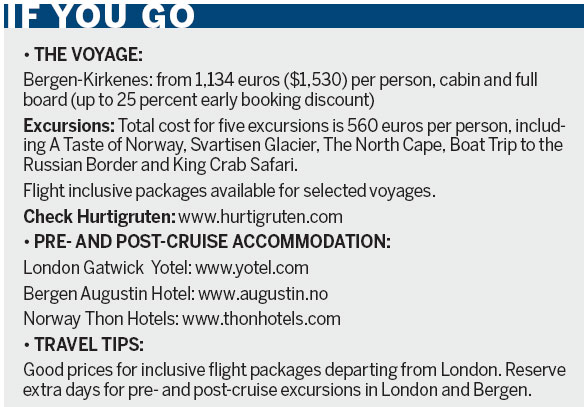
(China Daily 12/08/2013 page10)
Today's Top News
Cameron answers questions on Weibo
Top legislature rejects JP resolution
Haze chokes China's east, north
S. African politics not affected
China film festival opens in London
Nations to jointly tap nuclear markets
Xi leads China's tributes to Mandela
Smog gives expats second thoughts
Hot Topics
Lunar probe , China growth forecasts, Emission rules get tougher, China seen through 'colored lens', International board,
Editor's Picks
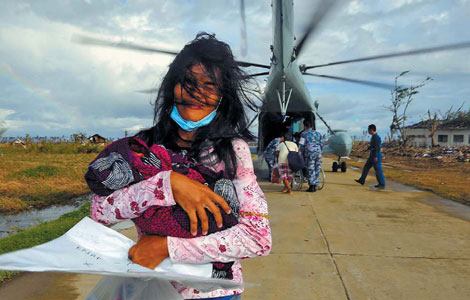
|

|
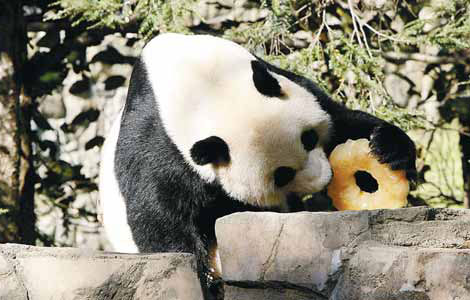
|
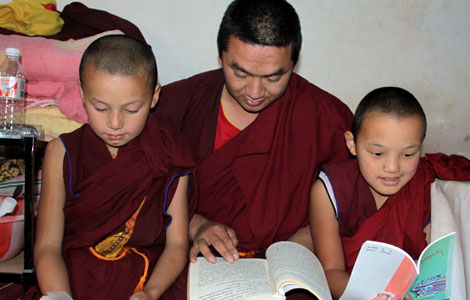
|

|

|
